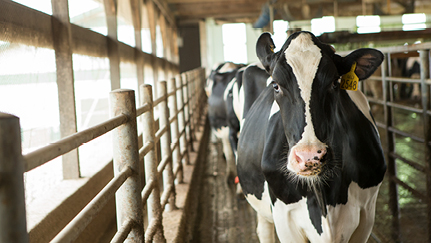Dairy farms migrating from west to east
After a westward migration decades ago, California has been the leading dairy-producing U.S. state. But that’s changing as farmers move back into the Midwest and Northeast. Factors behind the trend include high land and feed costs, environmental regulation and water scarcity.
“Farmers often see lower land costs and improved forage production capacity in the Midwest and Northeast compared to the West Coast,” said Nationwide Senior Dairy Consultant Dan Rice. “Dairy farmers are moving where they can access the feed they need, whether they grow it themselves or buy from another producer.”
At the same time, dairy processors are evolving what they produce and where they produce it. The planned construction of new large-scale processing plants in regions like upstate New York signal the industry’s growing confidence in the geographic trend underway among dairy farmers. In the long term, Rice said he expects this to stabilize the dairy market for farmers supplying milk to companies like Chobani and Coca-Cola Co.’s Fairlife.
New ‘clusters’ of dairy production
These trends are creating new clusters for dairy production and processing. Especially in key growing dairy states like New York, Kansas, South Dakota and Michigan, it’s enabling both farmers and their processors to capitalize on a few competitive advantages:
- Economies of scale. Larger, modern processing plants can achieve greater efficiencies and lower per-unit costs.
- Infrastructure development. The concentration of processors attracts investment in infrastructure like transportation and specialized service providers.
- Market access. Proximity to growing population centers and access to established distribution channels make these regions attractive for processing.
- Product diversification. Modern processing facilities are equipped to handle a wide range of high-value specialty dairy products beyond traditional fluid milk.
"Dairy farmers and processors are increasingly aligning their operations regionally, moving away from geographically dispersed production and processing," Rice explained. "This shift is concentrating state-of-the-art processing facilities in dairy-friendly states with strong consumer demand, particularly in the Midwest and Northeast."
Extending the shelf life of dairy products
Two newer processing methods are ramping up production of high-value output and bolstering supply chains and strengthening market opportunities for dairy farmers:
- Extended shelf-life (ESL) milk. This milk undergoes more rigorous processing like microfiltration and ultra-pasteurization. This helps extend the shelf life of the milk compared to conventional pasteurized milk. Often lasting several weeks under refrigeration, this extended shelf life:
- Streamlines distribution across wider geographical areas
- Reduces spoilage
- Meets the demands of modern supply chains and consumer shopping habits
- Milk powders. The production of milk powders has also seen major growth. Much of that growth is in the export market, especially for regions with unstable domestic milk supplies. Converting fluid milk into powder offers advantages like:
- Drastically extended shelf life
- Reduced transportation costs due to lower volume and weight
- Versatility as an ingredient in various food products
- Dairy Ingredients. The production of dairy proteins and fats is on the rise, driven by growing interest in health and wellness. Many new products, such as protein bars and shakes, now feature dairy proteins and fats as key ingredients. Additionally, dairy fats like butter and cream are experiencing a resurgence, making a strong comeback in various products.
“These products reflect the industry’s evolution to meet changing consumer demands,” Rice said. “On top of overcoming logistical challenges, we are able to get dairy products to more markets more efficiently.”
